Paul Gilster's Blog, page 199
June 26, 2014
Intergalactic Travel via Hypervelocity Stars
We’ve been looking at not just interstellar but intergalactic crossings in the past few days, something of an homage to Carl Sagan, whose enthusiasm for continuous acceleration at 1 g and relativistic time dilation was immense in the years shortly after Robert Bussard’s key paper on interstellar ramjets. Without a working ramjet and largely unaided by time dilation, we’re faced with millions of years of flight time to reach M31. What to do?
In a recent paper, discussed here by Adam Crowl on Monday, Robin Spivey ponders ‘autonomous probes that spawn life upon arrival’ as a way of reaching the Virgo cluster, which he wants to do for reasons Adam explained in his post. He’s also counting on continuous acceleration at 1 g for these small ‘seed ships,’ but other than mentioning antimatter, he doesn’t explore how this would be done, and we’ve seen the results Sagan and Iosif S. Shklovskii came up with for antimatter when they worked out the equations.
Let’s assume that the ‘slow boat’ solution is the only practical way to proceed. Here I think Adam’s suggestion that we take our environment with us rather than building a worldship is sensible, flinging a small star and planet out of the galactic core toward the destination. Ray Villard pondered the same question back in 2010 in an online piece called The Great Escape: Intergalactic Travel is Possible. He points to the four million solar mass black hole at the center of the Milky Way as the only conceivable way to impart the needed kinetic energy to a star.
Here’s how Villard describes the mechanism:
The theory is that a star could be slingshot out of a binary star system if the stellar duo swung close to the central black hole. The hole’s gravitational tidal forces would break apart the pair’s gravitational embrace.
The companion star orbiting in the direction of the black hole would pick up momentum and plunge toward the black hole. In accordance with Newton’s third law of motion — action-reaction — the other binary companion would go whizzing off with the same velocity but opposite direction away from the black hole.
In just a few thousand years the star would ascend out of the galactic plane and hurtle deep into intergalactic space. The persistent tug of our Milky Way’s dark matter halo would slow it down but the star would never fall back into the Galaxy.

Image: Using ESO’s Very Large Telescope, astronomers have recorded a massive star moving at more than 2.6 million kilometres per hour (1160 km/sec). Credit: ESO.
We do in fact know about a number of such hypervelocity stars, some of which may be moving fast enough to exceed galactic escape velocity. Consider this: Ordinary stars in the Milky Way have velocities in the range of 100 kilometers per second, while some hypervelocity stars near galactic center show velocities of ten times that, closing on 1000 km/sec. Meanwhile, a team led by Tilmann Piffl (Leibniz Institute for Astrophysics, Potsdam) that has been working with high-velocity stars has calculated escape velocity for objects in the vicinity of our own Solar System. The team uses data from the Radial Velocity Experiment (RAVE) survey.
The result: We would need 537 kilometers per second to get our payload fast enough to escape the galaxy. That’s a high speed, of course, but in terms of small craft, it’s not a lot higher than some studies have shown a solar sail could reach using an extremely tight ‘Sundiver’ maneuver to let itself be whipped out of the Solar System. Piffl’s team has catalogued hypervelocity stars moving at 300 km/sec, and we also know of unbound hypervelocity stars (although it’s a tricky call because of uncertainties about the mass distribution of the galaxy). Even some neutron stars are fast-movers: RX J0822-4300 was measured to move at 1500 km/sec in 2007.
Not all hypervelocity stars come from encounters with the black hole at galactic center. In work described at the American Astronomical Society meeting in January, Kelly Holley-Bockelmann and grad student Lauren Palladino found what may be a new class of hypervelocity stars moving with sufficient speed to escape the galaxy (see Stars at Galactic Escape Velocity). Says Holley-Bockelmann:
“It’s very hard to kick a star out of the galaxy. The most commonly accepted mechanism for doing so involves interacting with the supermassive black hole at the galactic core. That means when you trace the star back to its birthplace, it comes from the center of our galaxy. None of these hypervelocity stars come from the center, which implies that there is an unexpected new class of hypervelocity star, one with a different ejection mechanism.”
As we learn more about what creates hypervelocity stars, can we imagine far future technologies that might help us exploit them? If so, an intergalactic journey opens up. A civilization that somehow harnessed a hypervelocity star for such a journey — or one that arose on a planetary system that had been already flung into intergalactic space — would experience eons in the space between the galaxies, periods that dwarf the lifetime of human civilizations. Villard speculates about the astronomers of such a civilization trying to discover their place in the universe as their ‘worldship’ exited the Milky Way, globular clusters peppering the sky, the galaxy’s spiral arms winding out from a nucleus looking like ‘a fuzzy headlamp.’
Inevitably larger telescopes would yield a view of the universe that revealed myriad other pinwheel structures. Spectroscopy would show they are racing away too. Still the aliens literally wouldn’t know if they’re coming or going. A long-lived civilization’s science archive would note the shrinking and dimming of the Milky Way over geologic time. They might conclude that the eerie pinwheel is speeding away from them. And without a cosmological or stellar framework, they would have no idea of cosmic evolution. They would not even be able to calibrate the vast distance to the Galaxy.
But let’s assume for the sake of argument that a civilization might knowingly set out on a hypervelocity star system, its futuristic powers vast enough to shape the encounter between the star and the galactic black hole so as to direct its journey to the proper destination. Any culture that did this would knowingly be splitting into different evolutionary lines given the immensity of the distances and time involved, leaving behind its own species to grow into another over the course of millions of years. Whether and why any species might choose to make this kind of a journey is an exercise left to the reader, and to the imagination of science fiction writers.
We’ve seen stars manipulated for a variety of purposes in science fiction, as a matter of fact. Tomorrow I’ll wrap up this week of speculations on intergalactic travel with a look at some of the methods that have been employed to move stars around, and the possible SETI implications that arise from all this.
The Piffl paper is “The RAVE survey: the Galactic escape speed and the mass of the Milky Way,” submitted to Astronomy & Astrophysics (preprint). The Palladino paper is “Hypervelocity Star Candidates in the SEGUE G and K Dwarf Sample,” The Astrophysical Journal Vol. 780, No. 1 (2014), with abstract and preprint available.






June 25, 2014
Sagan’s Andromeda Crossing
When Carl Sagan and Iosif S. Shklovskii discussed travel to another galaxy in Intelligent Life in the Universe (Holden-Day, 1966), they considered the problem from the standpoint of the technologies then under discussion by theorists like Robert Forward and Robert Bussard. As I mentioned yesterday, the authors found hibernation interesting, drawing on the ideas of the Swedish biologist Carl-Göran Hedén, with whom Sagan was then in contact. But it was time dilation that took center stage in their book, and that required stunning velocities. To reach M31, the Andromeda galaxy, in a human lifetime would require a velocity of 0.99999 c.
Behind the relativistic spacecraft on Earth, millions of years would have passed, but the same crew that departed would reach their destination. Here is Sagan discussing the matter. And a brief note: Sagan’s practice was to interleave his own material with that of Shklovskii, so that while the names of both authors are on the title page, it’s easy enough to extract who wrote what because Sagan’s material is marked paragraph by paragraph where it is inserted. So these are Sagan’s thoughts on time dilation, from the perspective of those left behind on Earth:
Of course, there is no time dilation on the home planet. The elapsed time in years there approximately equals the distance of the destination in light years plus twice the time required to reach relativistic velocities. This time, at an acceleration of about 1 g, is close to one year. For distances beyond about 10 light years, the elapsed time on the home planet in years roughly equals the distance of the destination in light years.
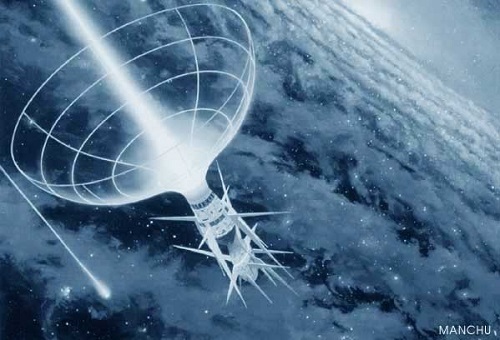
Now things get interesting, because a spacecraft moving with a constant acceleration of 1 g needs just a year to be traveling close to the speed of light. But Einstein’s special relativity reminds us that continuing to accelerate would not take the craft faster than the speed of light, but only closer and closer to it. As that process continues, time dilation gets more and more extreme. Sagan continues:
Thus, for a round-trip with a several-year stopover to the nearest stars, the elapsed time on Earth would be a few decades; to Deneb, a few centuries; to the Vela cloud complex, a few millennia; to the Galactic center, a few tens of thousands of years; to M31, the great galaxy in Andromeda, a few million years; to the Virgo cluster of galaxies, a few tens of millions of years; and to the immensely distant Coma cluster of galaxies, a few hundreds of millions of years. Nevertheless, each of these enormous journeys could be performed within the lifetimes of a human crew, because of time dilation on board the spacecraft.
When I was first getting involved in interstellar studies and talking to as many people as I could track down with experience in the field, I had a phone conversation with Gerald Nordley, whose work I was familiar with in places like Analog. I remember an off-the-cuff remark Nordley made, that it would make sense for the first human expedition to Alpha Centauri to be conducted at .86 the speed of light. Why that number? Because if you can reach .86 c, the time compression factor is two. Your crew experiences half the amount of time that those left behind will experience. And that makes for an Alpha Centauri crossing of about three years, on the order of Magellan’s circumnavigation of the Earth.
Of course, this is all so highly theoretical that it beggars description. How do you get velocities like that? We saw yesterday that while Carl Sagan had a deep interest in the work of Robert Bussard on interstellar ramjets (he described the ‘elegance in its conception,’ cited the fact that it violated no physical principles, and thought a Bussard ramjet could be built within a century), later studies have revealed serious flaws in the concept. In the archives here are a number of articles exploring ‘fixes’ to the original Bussard idea, and in coming months I’ll reprise these possibilities. Sagan also explored antimatter solutions but saw problems in manufacture and containment.
But even if we could somehow manufacture antimatter in sufficient quantities and contain it safely, the equations were merciless. Remember, we’re trying to reach 0.99999 c to make this Andromeda crossing. Even assuming complete conversion of the mass of the fuel into energy, with all energy released utilized for thrust (an ideal unlikely to be achieved), the total mass of the fuel would have to be 200,000 times greater than the mass of the remainder of the spacecraft. As Sagan dryly wrote: “…an interstellar space vehicle powered by anti-matter and requiring a mass ratio of 200,000 does not seem to be an elegant solution to this problem.”
In Martyn Fogg’s paper “The Feasibility of Intergalactic Colonisation and its Relevance to SETI” (citation below), having looked at the problems of the Bussard ramjet and pondered human life suspension, the author considers worldships as a non-relativistic way to reach another galaxy. Here the difficulties are likewise immense, with one concept (by Robert Page Burruss) involving a worldship a thousand miles wide carrying up to 50 billion people, to be sent on the ultimate generational voyage, one lasting hundreds of thousands of generations. As science author Adrian Berry notes, this is five times the past age of the human species.
Sagan didn’t like the mass ratio of his Andromeda ship, but Burruss came up with 500 billion tons of antimatter and an acceleration period of 50,000 years to make this work. And you can forget about relativistic efforts even with all that antimatter. This is a craft that would reach about 40 percent of the speed of light, so that relativistic time dilation is slight. Berry also notes that there is no provision in this design for artificial gravity generated by spinning the ship, making it an open question how evolution would treat a human population that evolved over a period of millions of years in weightless conditions. Fogg calls the Burruss ship “too ‘heroic’ to be taken seriously.” He also states:
…because of the great length of time involved in an intergalactic voyage the problem of creating a closed ecosystem capable of supporting a viable population is far greater. The only self-contained ecosystem we have knowledge of that remains habitable over a time scale of millions of years is the Earth’s biosphere. Life flourishes under conditions maintained by atmospheric, chemical, geological and biological feedback loops, driven ultimately by sunlight and the internal heat of the Earth. A galaxy ship carrying a fully and continuously functioning ecosystem might thus have to be the size of a small planet and capable of carrying a powerful long term energy source.
Which gets us to the most interesting part of the above description: A worldship the size of a small planet carrying its own long-term energy source sounds much like what Adam Crowl described on Monday, a small star and planet pair that can be flung out of the galactic core. Tomorrow I want to look at this idea — the adjustment of the trajectories of the stars themselves to migrate outward — as a non-relativistic solution to galaxy-spanning distances.
The Burrus paper is “Intergalactic Travel: The Long Voyage from Home,” Futurist 21 (1987), 29-33. And here again is the Fogg citation: “The Feasibility of Intergalactic Colonisation and its Relevance to SETI,” Journal of the British Interplanetary Society Vol. 41 (1988), pp. 491-496.






June 24, 2014
Deep Time: Targeting Another Galaxy
Interstellar flight isn’t about possibility as much as it is about time. We know we can launch a payload to another star if we’re willing to burn up enough millennia — about seventy — to get there in the form of a Voyager-style flyby. That’s with today’s technology, and we can extrapolate how the time frame can be shortened with improved materials and propulsion techniques. So as Robert Forward always pointed out, it’s not that interstellar flight is impossible — it’s that it’s very difficult, and our expectations of the kinds of missions possible have to adapt to that fact.
Intergalactic flight, though, is such an immense undertaking that I’ve rarely discussed it in these pages. Is there any conceivable technology that might make such a thing possible? Well, Carl Sagan and Iosif S. Shklovskii considered the situation in Intelligent Life in the Universe (Holden-Day, 1966), working with the opportunity for time dilation opened up by special relativity. Accelerate at 1 g continuously and time dilation helps you to reach nearby stars in just a few years as time is measured aboard your spacecraft.
The numbers get more and more mind-boggling as you continue to work the equations. With that same 1 g acceleration (and just how you achieve that is of course the grand question), you can make it all the way to the center of the Milky Way in about 21 years — tens of thousands of years would have passed on Earth by the time you arrived at the galactic core. Or go for the ultimate journey: A voyage to the Andromeda galaxy. To reach M31 in a ship of this sort would take 28 years ship-time as you nudged ever closer, but never reached, the speed of light. As always, I point to Poul Anderson’s Tau Zero as the novelistic embodiment of Sagan and Shklovskii’s musings, as fresh today as when it ran in Galaxy in 1967.
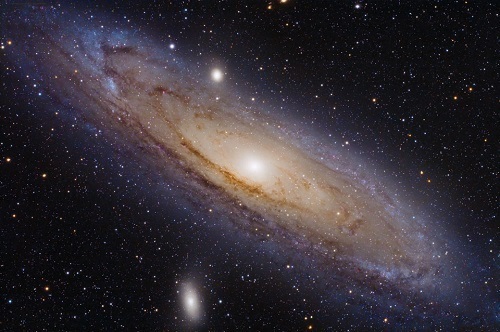
Image: M31, the closest major galaxy to our own. Continuous acceleration at 1 g would allow a human crew to reach it, but what conceivable technology would allow such a craft to be built? Image credit & copyright: Lorenzo Comolli.
Yesterday Adam Crowl mentioned Martyn Fogg’s paper “The Feasibility of Intergalactic Colonisation and Its Relevance to SETI,” in the context of Robin Spivey’s ideas on galactic migration. Fogg runs through the possibilities for intergalactic journeys including constant 1 g acceleration of the kind Sagan and Shklovskii talk about. Robert Bussard had proposed in 1960 that this kind of acceleration could be achieved through a fusion-powered ramjet design that fed off the interstellar medium. It would be a tough engine to light but once you got the ship moving fast enough, a self-sustaining reaction seemed to be possible, and it’s more or less the concept that Anderson used in Tau Zero for his starship.
But Fogg nails the problem with the Bussard ramjet, or I should say, the problems, there being several intractable issues to be faced. Robert Zubrin and Dana Andrews have shown that as the ramjet accelerates, the vast electromagnetic ‘scoop’ being used to collect fusion fuel actually begins to act as a brake. See Starships: The Problem of Arrival for more. And as early as 1972, A. R. Martin had discussed structural limitations that would prevent such a ship from sustaining accelerations this close to the speed of light.
Surmount even these difficulties and you run into perhaps the biggest showstopper. Gas density between the galaxies is, in Fogg’s estimate, 10-5 lower than what the ramjet would encounter within a galaxy. Gaining enough fuel, then, would be the challenge, and as we’ve learned more about the interstellar medium, it seems clear that a ramjet would have problems even within the Milky Way depending on the local density of interstellar material. That leaves only David Froning’s suggestion of a ‘quantum ramjet’ using quantum fluctuations of the vacuum, an idea that would assumedly not be constrained by the Bussard ramjet’s fuel problems.
Is there any other way to save the idea of intergalactic travel close to c? Fogg doesn’t think so. From his paper:
…irrespective of the propulsion system used, hyper-relativistic intergalactic travel would be fundamentally limited. The velocity of the ship at midpoint would be so close to c that no interaction with intergalactic matter would be permitted. Dust grains would impact like cannon shells and hydrogen atoms would take on the characteristics of a lethal and penetrating form of cosmic radiation.Thus, leaving aside the feasibility of a “quantum drive”, the use of time dilation to significantly reduce elapsed intergalactic voyage times would not be practical unless a way could be found of preventing impacts from oncoming particles.
That’s a pretty good list of seemingly insurmountable problems, all generated by the fact that we’re trying to get the crew that set out from Earth all the way to its destination. Give up on that constraint and a number of other possibilities open up that make us weigh interstellar and intergalactic flight against our concepts of deep time and the lifetime of civilizations. Sagan and Shklovskii didn’t pin their entire argument on Bussard-style craft. They also explored the potential of human hibernation on journeys lasting thousands of years. But there are other possibilities, some of them discussed by Adam Crowl yesterday, that I want to explore tomorrow.
The Fogg paper is “The Feasibility of Intergalactic Colonisation and its Relevance to SETI,” Journal of the British Interplanetary Society Vol. 41 (1988), pp. 491-496 (available online). Robert Bussard’s ramjet paper is “Galactic Matter and Interstellar Spaceflight,” Astronautica Acta 6 (1960), pp. 179-194. Andrews and Zubrin’s paper on the Bussard ramjet and drag is “Magnetic Sails and Interstellar Travel,” International Astronautical Federation Paper IAF-88-5533 (Bangalore, India, October 1988), although I’ll also point you to Zubrin’s Entering Space: Creating a Spacefaring Civilization (New York: Tarcher/Putnam, 1999). The Froning paper is “Propulsion requirements for a quantum interstelllar ramjet,”JBIS, 33, 265-270(1980).






June 23, 2014
A View of the Deepest Future
Adam Crowl first appeared in Centauri Dreams not long after I opened the site to comments about nine years ago. His insights immediately caught my eye and challenged my thinking. I have always admired auto-didacts, and Adam is an outstanding example: “I don’t work in this field nor did I especially train in it,” he writes. “I did physics/maths/engineering study but my astrophysics, astrodynamics, planetology and interstellar propulsion knowledge is self-taught.” The list of books in the various disciplines — as well as science fiction — by which he did this will, I hope, become a future Centauri Dreams article. Adam writes the Crowlspace blog, is active in Project Icarus, the re-design of the 1970’s Project Daedalus fusion starship now in progress at Icarus Interstellar, and is a frequent participant on this site, often pointing me to papers I would otherwise have missed. The one he discusses today is, typically for Adam, a true mind-bender.
by Adam Crowl

The long-term fate of Life in this Universe is rarely contemplated. A few landmark studies, by Freeman Dyson, then Fred Adams, Peter Bodenheimer & Greg Laughlin, have looked into Deepest Time, long after Matter itself fails and the Void becomes unstable. How far can biological Life extend into the Long Dark? A study by Robin Spivey extends Life’s tenure, in neutrino-annihilation warmed Ocean Planets, to 1025 years – and Beyond. That’s 100 times longer than the 1023 years we’ve reported here previously and some 1,000 trillion times longer than the time the Universe has presently existed. If the current Age of the Universe was a clock tick – a second -, then those 1025 years would be 20 million years.
Spivey discusses his new finding here: Planetary Heating by Neutrinos: Long-Term Habitats for Aquatic Life if Dark Energy Decays Favourably [Open Access article]. Outer-shell electrons of 56Fe (iron) inside the cores of Ocean-Planets become ‘catalyzers’ of Inverse Photo-Neutrino Process (IPP) reactions, annihilating neutrinos and creating a steady heat-flow sufficient to warm the planet at ~0.1 W/m2. This Figure, published in the paper, illustrates the flow:
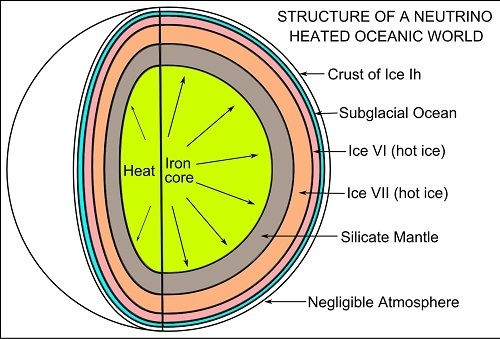
Perhaps coincidentally, the inexorable processing of stellar materials in Type Ia Supernovae leads to a chemical mixture which makes Earth-like planets. Each Type Ia Supernova masses about 1.4 Solar Masses, or about half a million Earths, with the ejecta debris being mostly iron, then oxygen and silicon. Earth-stuff. Thus the ‘ashes’ of stars can produce a multitude of Ocean Planets.
To quote Spivey:
Observations have determined that the ejecta of a typical SNIa are, by mass, 18% oxygen, 15% silicon, 13% iron, and 49% nickel (almost all in the unstable form 56Ni which decays radioactively to 56Fe), along with smaller amounts of carbon, calcium, sulphur and magnesium. Elements emerge from SNIa in strata, with the lightest occupying the outermost layers. This provides the oxygen-rich outermost shell with the best opportunities for reacting with hydrogen in the interstellar medium, resulting in the formation of water molecules. On cooling to temperatures found in deep space, ice XI is obtained, whose ferroelectric self-aggregation may be relevant to comet formation [38-40]. The bombardment of protoplanets with comets would be important to the formation of oceanic planets, deferring the delivery of water to their surfaces.
Notice that the iron component is 62% by mass, thus the very large core in the illustration. Quoting Spivey again:
Based on the composition of type Ia supernova ejecta, a hypothetical oceanic planet of one Earth-mass is projected to consist of a large iron core of radius ~4240 km surrounded by a silicate mantle of thickness ~1300 km through which heat would be transported by advection. External to this inner mantle would be an outer mantle of ice consisting of strongly convective ice VI and VII phases of combined depth ~320 km. A liquid ocean ~50 km in depth covered by a solid crust of ice Ih upwards of 50 m in thickness would overlie the hot ice mantles.
Spivey’s new paper focuses on how the supply of neutrinos can be maintained at the right density to keep planets warm for the maximum amount of time. He posits several, as yet, unobserved processes – the decay of dark energy into neutrinos in less than ~70 billion years and the accelerated decay of black holes, also preferably into neutrinos. Other researchers have posited the existence of ‘sterile’ neutrinos, which Spivey shows improves the characteristics of the neutrino halo surrounding a Galaxy cluster, enabling planets to be warmed in a life-friendly manner in a sphere of 400 thousand light-years radius.
The existence of Dark Matter itself has been called into question by physicists, such as Mordechai Milgrom, who think the evidence for invisible Dark Matter can be equally well explained by modifying Newtonian Gravity to have a minimum gravitational acceleration. This Modification of Newtonian Dynamics (MOND) theory neatly explains the structure of galaxies, but hasn’t been as successful on a cosmological scale. Intriguingly if Galactic haloes are made of sterile neutrinos, then MOND and Dark Matter physics are equivalent in outcomes: Reconciliation of MOND and Dark Matter theory with giant ‘Neutrino Stars’ forming around each large Galaxy. Spivey suggests that a key research priority is determining the properties of neutrinos, to confirm the IPP heating mechanism. Such neutrino studies are important for refining the Standard Model of particle physics – and possibly discovering new physics, such as the masses of the various neutrinos, something not predicted by the Standard Model.
Spivey’s most audacious suggestion is the strategy that Life should adopt in the next few aeons to extend its lifespan. Unfortunately for Life in this Galaxy, our local Group of Galaxies is insufficiently massive to form a large enough neutrino ‘star’ before Dark Energy spreads galaxies too far apart. To survive, Life in our Local Group needs to emigrate to the Virgo Super-Cluster. Although our Milky Way is heading towards Virgo at ~200 km/s, cosmic acceleration, from Dark Energy, is presently pushing us away from Virgo at ~1,000 km/s. Thus we need to launch towards Virgo faster than the Dark Energy pushing us away. Yet the reward is 10 trillion trillion years of Habitable planetary environments, which may well be worth intergalactic migration.
Spivey suggests using antimatter rockets to launch modest payloads. Essentially small Life-seeds, like those proposed by Michael Mautner to seed Life in our own Galaxy, but launched on intergalactic journeys of a hundred or more billennia. Whether the cosmic-ray flux between the Galaxies can be endured for geological epochs is presently unknown and while I wouldn’t rule it out, it seems unlikely at best. A good reference, available online, is still Martyn Fogg’s “The Feasibility of Intergalactic Colonisation and its Relevance to SETI”, which suggests how a mere 5 million year intergalactic voyage might be survived by a bio-nanotech seed-ship.
But we’ve discussed other options in these pages previously. In theory a tight white-dwarf/planet pair can be flung out of the Galactic Core at ~0.05c, which would mean a 2 billion year journey across every 100 million light-years. A white-dwarf habitable zone is good for 8 billion years or so, enough to cross ~400 million light-years. It’d be a ‘starship’ in truth on the Grandest Scale. Perhaps other Intelligences have begun their preparations earlier than us and we should look for very high-velocity stars leaving the Milky Way and Andromeda’s M31. Over the next aeon we might observe many, many stars flinging towards Virgo from the nearby Galactic Core black-holes.





June 20, 2014
Woven Light: Lesson Arcs
Heath Rezabek continues his experiment in possible futures, science fiction with a collaborative bent exploring the archives that may one day preserve the story of our world and the sometimes mysterious processes that may bring them into being.
by Heath Rezabek
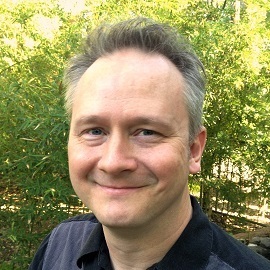
This is the fifth installment in a continuing series of speculative fiction here on Centauri Dreams. Feedback from prior installments helps shape the themes and direction of subsequent entries, but the purpose and focus of these pieces is to explore a timeline (or timelines) in which comprehensive, resilient archives of Earth’s biological, scientific, and cultural record — deep archives for deep time — are developed through unexpected means.
Woven Light (I) – Vessel Haven http://www.centauri-dreams.org/?p=29669
Woven Light (II) – Adamantine http://www.centauri-dreams.org/?p=29897
Woven Light (III) – Augmented Dreamstate http://www.centauri-dreams.org/?p=30128
Woven Light (IV) – Proteaa http://www.centauri-dreams.org/?p=30352
Woven Light (V) – Lesson Arcs
- – - – -
In my last installment, we launched the Centauri Dreams Vessel Survey, beginning community curation of a core booklist embodying Centauri Dreams‘ themes and influences. I discussed my work with the Long Now Foundation, showcasing their work and discussing my pending trip to be present for the opening of The Interval. We will return to both of these topics in a future installment. This week, however, I’ll continue the speculative fiction arc of Woven Light here on Centauri Dreams.
2013 was a tremendous year of change and evolution for the Vessel project; in the span of that year, the Vessel proposal moved from being a conference presentation to a published proceedings paper. After joining Icarus Interstellar to help organize the first Starship Congress, the Vessel project was summarized and presented at the event. A monograph version of that session should ultimately find its way to the JBIS special issue on SC2013.
At that conference, I met Paul Gilster, and introduced him to Nick Nielsen: There began a collaboration which continues today. Perhaps the biggest advancement of all, for me, was the opportunity to serve as an Intern with the Long Now Foundation as they began the community curation process for their Manual for Civilization collection. Although this Internship is drawing to a close, the effort has planted seeds that will continue to sprout for years to come.
With clarity can sometimes come a contradictory confusion. Even as progress on the Vessel proposal assured me that this effort had much in store, I soon discovered a large complication: To make progress on the practical proposal — the Vessel Open Framework, a specification document which could help pave the way for a unified approach to very long term archives — I realized I would need time and a team. Neither of these things are easily secured. My time remains split between these efforts and my livelihood.
Sometimes, however, help comes in unexpected forms. In this case, my conflicted feelings on how to proceed with the Vessel proposal led to a rediscovery of fiction as a vehicle for evoking and envisioning possibilities that remain unreachable in reality. My work on the Woven Light story arc continues, and if anything, is picking up steam.
Likewise, with this realization has come another shift in my perspective. While I continue to feel that a practical proposal for scalable, widespread archival efforts of all kinds is necessary, I have also come to realize that equally important is the collective role of storytellers as living archives of potent possibilities. One path forwards with Woven Light is to create a kind of fiction which can be approached from many directions, including by those inspired enough by it to try their hand at its themes and scenarios themselves.
Should humanity fail in its task in the short term, and Vessel Archives (or their like) not be constructed or created in time to forestall scattered cultural collapse or stagnation, it becomes crucially important that the stories with which humanity is left retain a trace of incentive towards rebuilding. Some would say that our advancements will soon outpace our challenges. Others would say that cases of permanent stagnation and flawed realization are already underway, in nations around the world which struggle against tides of poverty or political despair.
Where, then, is the wellspring of inspiration needed to renew a belief in the possible? Even as I continue to work at the Vessel proposal as a practical deliverable, I am working more and more on a way of storytelling which above all else plants seeds of potential in the gaps between what we can foresee and what we collectively doubt is possible.
It was a surprise, in writing, to find Thea Ramer revising the first sections of Woven Light in response to the entreaty that her robots and starships were never going to make it far in the fictional world of her present-day (an alternate-timeline 1990s), which was in turn a response to the overarching suspicion of previous comments. The resurgent myth which emerged at that point is going somewhere — Vaachez descends into the bazaar in search of a guide and map to even deeper passages, and not all in the storyline is as it seems.
As we move forwards, the number of timelines at work may begin to collapse and merge a bit — and other, unexpected ones may open up. With silence in the comments, I forge ahead sounding out the way based on the echoes already at work in the world of the story. Always, of course, comment is welcomed — it’s no longer expected: All of us, perhaps, are in unexplored territory.
One thing I do foresee is that the Vessel Open Framework will begin to unfold again, from within the world of the fiction. I take as an inspiration the experience I had in 1991 when, well after the original TV series of Star Trek: The Next Generation had ended, I encountered the ST:TNG Technical Manual, by Sternbach and Okuda. Though this kind of metafictional resource had been published before, something about the depth of thought and description in this work inspired me towards a new kind of fiction, one in which the only limits are those of our own vision, deduction, and imagination. [1]
I am thankful in the extreme to Paul Gilster, for his constant encouragement and support of this effort, a form of serialized fiction perhaps not seen before on Centauri Dreams, but now belonging thoroughly to it. I am grateful for his patience as I work my way towards a myth of possible futures that somehow includes as many possibilities as we can foresee, and asks us as readers to choose between them. Which will we accept or reject? Which will we create through our vision, or our blind spots?
Even for me, there is only one way to know, and that is to follow the work where it goes.
[1] Okuda, M and Sternbach, R. Star Trek: The Next Generation Technical Manual (Pocket Books, 1991).
- – - – -
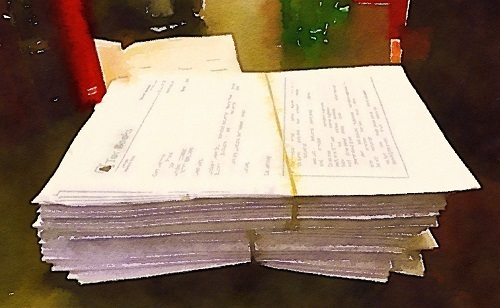
[Image 1 - ‘Manuscript: The Tracer Guild Book 1 by Thea Ramer.’ Adaptation of photography CC BY-SA Cory Doctorow ]
1994. Thea Ramer continues her work on a novel that will be called The Tracer Guild. It will be her only published work, and will reflect but a sliver of the world she is to sketch out between now and its publication in December, 1996. These two years will be spent, for her, in a frenzy of creation, drawing upon notes she has been reworking for several years already.
The Tracer Guild — planned as the first of a series — goes so confidently astray as to float the working titles of six more planned volumes. It enjoys a brief period of uptake, before becoming overwhelmed by the market. After its publication, exhausted and bemused, Thea will put aside the work, only to return many years later, by another route entirely. And she will go through many changes.
For one, she will determine to pick up her scientific pursuits again, and return to academia. This will ultimately result in her team’s development of hologlyphic syntax, and from its hologlyphic origins, the synthetic mind called Avatamsaka.
For another, she will bear a son. His name will be Aben.
- – - – -

[Image 2 - ‘CU Boulder: Resilience, Remembrance, and the Future of Humanity Symposium 2024.’ Adaptation of photography CC BY-SA devnulled 2010 ]
2023. Aben Ramer returns to Denver from the Playa, prepared to dedicate his energy to a community knowledge and resiliency center, and grassroots version of specification document known as the Vessel Open Framework. The next year, a chance meeting at a conference at CU-Boulder introduces him to Professor of Computational Psychology, Dr, Jota Kaasura.
Resilience, Remembrance, and the Future of Humanity. Symposium 2024.
Lunch Keynote: From Active Imagination to Synthetic Minds: Preserving Ancestral Symbology through Jungian Design Discovery in a Computational Matrix.
After the talk, by the side of the stage as the audience mills towards afternoon, Aben reaches the presenter. Records show him young and eager, an anxious spark in his eyes. Recovered from video, this transcript remains:
Ramer: Doctor — Dr. Kaasura, I wanted to thank you. I’d never thought about it quite that way — the synthesis […unclear…] meaning through visualization — thanks for painting the picture. Oh — I’m Aben.
Kaasura: Yes, thank you. Call me Jota. I appreciated your question, ah.., Aben.
Ramer: Thanks. Ok, well so, you also mentioned that your team was seeking volunteers for the Thematic Sampling phase of input. I’ve practiced Active Imagination before, just a little, and I’d love to participate. I’m in Denver, so getting to CU’s not a problem.
Kaasura: Ah! You have? Well, excellent! It’ll be a bit yet as we gather applications. Here’s the lab’s card. We can certainly explore the possibilities. We’ll take your application and history, and we’ll go from there.
Ramer: Great. Great!
Kaasura: Out of curiosity, how did you run across Active Imagination?
Ramer: My mother used to use it for creative inspiration. She was a writer, years back — she’s actually in AI research as well, now — holography, holographic syntax. Dr. Thea Ramer?
Kaasura (brightening): Ah! Yes, yes, I know her work. Small world! She’s — didn’t she break some new ground, so to speak, in New York last year?
Ramer: Well, yes, that’s — yeah, I guess it was a breakthrough, really. But after what happened, she’s actually on sabbatical now. She says she’s not sure if she’ll return to it. I’m not quite clear on why. But she’s writing it up, so there’s time. She’s here, in fact! Well, not here-here. She was’t up for the conference, too soon she says. But she’s staying with me in Denver. We’re going through her old fiction, her drafts, trying to catalog.
Kaasura: (…) Interesting. Yes, you know, I’d actually love the chance to speak with her, if the chance comes up. Holographic syntax holds great promise. It’d be a shame for her to let it go. I mean, work goes on, always, of course, but sometimes there’s a spark, and it’s always worth perking up when that’s so. Something worth doing, there.
Ramer: Yeah. I’ll tell her. She’ll appreciate it. Maybe we can set something up. I mean she’s right here, really… Too near for a miss, right?
Kaasura: Right. Right. Good way to put it! Well, there’s my card — I do have to go, but we’ll look forward to –
Ramer: Absolutely. Thank you. I really appreciate what you’re doing, and especially why you’re doing it. Thanks for sharing that.
Kaasura: Well, thanks for such an interesting question. The unexpected ones are the best, aren’t they?
Ramer: I’ll bet they are. Great. See you soon!
Kaasura: Yes. See you soon.
- – - – -
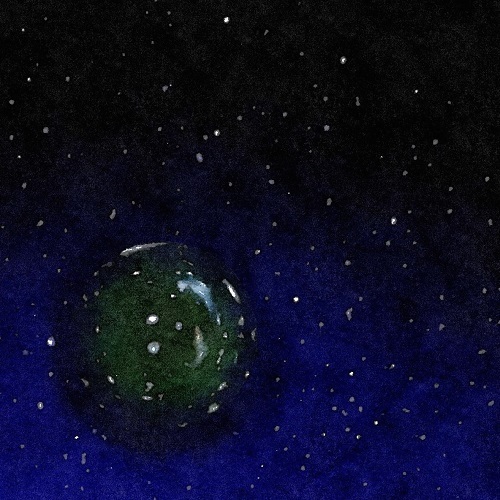
[Image 3 - ‘Proteaa: Dyson Eggs, Living Archives’ (Detail) Heath Rezabek. Adaptation of photography CC BY-SA Wikimedia. ]
Timeframe Unknown. A reflective, refractive sphere, brimming with a maelstrom of living matter, drifts through endless night, tracing the edge of gravity’s embrace. Though utterly alone, it is not lonely, as the Protean cells which form its very quanta are entangled with many other such vessels, peer civilizations spiraling in affinity. True entanglement is a strange thing. Most of these entangled peers are smaller than itself. Most do not share the same origin. Most do not share the same gravity (which means locality, or galaxy), or space, or time.
Some, though not all, have sails; and all such sails stream ancient light.
At least one of these bears passengers, deep in stasis, living — ponderously, glacially, but metabolically living — archives.
At least one of these living archives bears the name of Ramer.
And each Ramer contains the rest.
How did this come to be?
- – - – -

[Image 4 - ‘Pendulum: Lesson Arc’. Adaptation of photography CC BY John Morgan 2013. ]
It was possible to become lost in here.
This much was well known, and all were taught the telltale signs of probability sickness early on. Vaarea Ramer did well in her lesson arcs, the small worlds adrift in fog on which she had learned to discern Realia from its echoes and shadows and subcreations.
She tracked the arc of the pendulum, swinging, swinging above an ancient pool, reflecting a blinding blue sky with each pass. Ancient, it seemed. Swinging, she felt. It was easy, seeing such a simple scene, to believe it grounded and absolute.
But she stood upon a sort of observation deck, and between her and the pool lay a gap too wide to leap, filled with fog. And beside her stood her family’s Mentor, Tuavaadha, nodding behind her veil.
~Yes, Vaarea. The pendulum would stop in time, if we waited here long enough. But there is much more to do, and even I might become bored waiting so long as that.~
Vaarea lifted her eyes, scanning the clouds for signs of anything but stasis. Her thoughts felt like a sound she heard, unspeaking, though she was the one projecting. She was used to this by now. ~What else is there to do?~
~After the Pendulum Pool comes the Grotto; at least for you. And all of your line, stretching back and back, have found it more interesting a place to be.~ Tuavaadha smiled, she knew without seeing.
And of course, she knew that she was being nudged, poked and tested, gently but inevitably. Vaarea felt a familiar irritation, which resolved itself in its familiar way into a motion of the hand. Lifting from her sash a small shard of smooth stone, she rubbed it twice with her thumb, and felt its weight shift to signal that a beacon had been placed. She’d be back, she was sure.
~As sure as your father. As sure as your son.~ Tuavaadha strode forwards, holding out her palm. A Mentor’s palm seems as wide as night, when it’s open, thought Vaarea.
She placed the stone there, and waited for the blink. But this time was different. To her right, out of eyeshot, she felt something shift and slide, and turned to see a panel of the observation platform falling away. Underneath, familiar lines of woven light interlaced and parted, indexing the scene and retracing the Voronoi frame around them.
~What about the Grotto?~ she quested, following Tuavaadha below.
~We’ll get there, impatience. We just can’t from here.~
Vaa stopped, furrowed. ~Since when can’t we get to one pattern from another?~
~Since the time it was woven that way, which means everfore.~
They were moving now, wisdom bodies flowing past the index lattice, passing pods where her peers slept and drifted, suspended in the weave.
~How far, then?~
~Not far.~
~A different lattice?~
~A different loom.~
A different loom! Now surely there was no reason they couldn’t trace a thread from one pattern to any other while remaining in the same loom. Unless by design, but why?
~Security, for one part,~ rang Tuavaadha. ~But only one part. There is something to the journey, sometimes. Something worth doing. You should know this better than most, being spun as you have from the thread of all Ramers.~
The Ghemaai were not prone to resentment, but an ancestor of Vaarea’s might have felt something sharper at the reminder that great choices had been made for her, long before her, which as far as she knew she could not unchoose. But she knew that she was also here, and alive, and flowing starwards with them all, in a way she could not be had different choices been made. And she had her vows, and they were resilient.
~So what is this, then? This Grotto we can’t reach from anywhere?~
~Anywhere else~ adjusted Tuavaadha. ~The Grotto is a family weave. ~ They were passing, now, lightflows that would have led them off towards the flowing cores, or the gathering cores, or the sinking cores; but none of these did they follow.
Tuavaadha said nothing, but smiled beneath the quiet; and Vaarea followed. So they went, in silence, weighing the memory of her shardstone, lacing it between her fingers as their footfalls silenced the deck.
Up ahead, in time, they reached a branching, and another, and a last; and there Tuavaadha stopped, as she had many times before, and waited for Vaarea to read the weave before them. It was old, but always the first time it felt fresh to new eyes. In time, Tuavaadha knew, familiarity would bring a kind of slow sorrow more like joy, keen enough to earn a name. But this time was new time.
Vaarea blinked, reaching out to touch the woven pattern of this tale. There at its center was something she’d heard of, but never seen. A cubic lattice the size of her fist was held tilted and sunken in the center of a circular plateau. Leading out from it, threads spun and raveled, and shoots reached up from loamy soil, sheltering the small camp arrayed there. This close to the fabric, she could see that the lattice stood in for a fire.
Vaarea had learned of shelterfires not two lessons prior, and shivered at the glacial cold she thought they’d left behind in a liminal valley beset by frozen seas. Around this fire sat and stood a dozen, maybe fewer, maybe more; a handful huddled – but against what cold she couldn’t see.
These grassy trees seemed city walls for them, golden green and thriving. And their tips brushed at a dusted, starry sky.
She knew better than to trace too long the lines between these diamonds, but she couldn’t help seeing the similarity – a kinship she’d never noticed in these tapestries before – between the lattice at the heart of this little shelterfire, and the splaying array of stardust beyond these trampers’ reach.
These trampers, she guessed, had tramped the path to this pattern here and now. Why so huddled? Why so intent upon the fire, if not for warmth? It shimmered and billowed, a tiny curtain, golden and ghostly above embers.
She wished she could see one in Realia. She wished she could see one patterned here and now.
~But you can, Vaarea Ramer. And you always will be able.~
So reaching out, she brushed it gently with one fingertip. And sometimes, in such places, the slightest touch is enough.
- – -
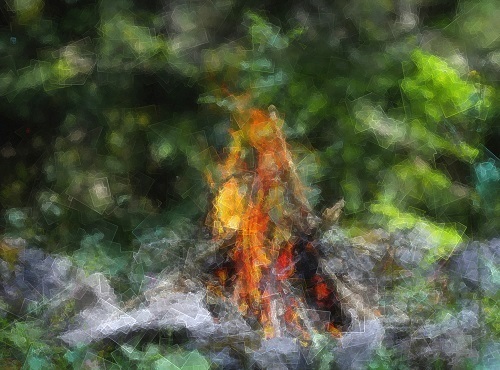
[Image 5 - ‘Woven Fire’. Adaptation of photography CC BY-SA Mathias Erhart 2009. ]
Aben Ramer sat before the fire, stirring its coals. “I am old, now… But once I was young, like you, and you as well,” he began.
Young eyes looked up, in awe at their elder. They had heard this beginning before, many times; always – every time – it ran on from there differently than the time before. And always – every time – it ran on like a new stream down the same mountain.
As old Aben Ramer spoke, the children gazed and rested, their eyes sifting firelight, and then lost themselves in patterns ever changing, never changed, woven of golden light; and in through its murmuring cracks could be glimpsed the most ancient of archives, finding itself revealed again, deciphered again, read out and comprehended, voiceless and booming.
Up reached Old Ramer’s arms,
and as tall as the shoots far above them he seemed;
and as full seemed the sky as their hearts and their eyes;
and the stars seemed as close as the sparks which there met them;
and as sure seemed the song of Old Ramer as morning.
And in the morning, the children awoke from dreams of a dragonfly in the night, flowing starwards, wings like sails unfurling, ringed about with an arcing bowl of starlight. And among them was a girl, whose name was a new one; they just called her V.
- – -
Vaarea, stunned, hours or years later, stood just as she had before the weave, finger fading from the cubic lattice turned to fire before her. Tuavaadha smiled. ~This place – can I come here?~
~Of course; any time. All you need to do is seek it, awake or asleep, and remember that you’re seeking.~ Tuavaadha paused. ~But it helps to have some methods. In the Grotto, you will learn them.~
~That wasn’t the Grotto?~
~It was, reflected. But emulators are for studies; this place is for dreaming. We can go there tomorrow. Tonight, your assignment is just to ponder one thing, while you rest and you wait.~
Vaarea looked up, still not fully present.
~?~
~The fire: Where did it come from? Where is it going? What does it preserve? What does it destroy? Is memory stored there? And if not there, then where?~
Vaarea looked at the lattice, shimmering softly, woven into this meshwork, and closed her eyes to recall true flame, true flame unseen but everthere. She furrowed; she sighed; she looked to her Mentor for more.
~These seem like different questions, but they are not. They are conjoined. Why? For matter–
–is slumbering light~ Vaarea concluded.
Tuavaadha nodded contentedly, as any Mentor would. ~Now rest.~
- – - – -
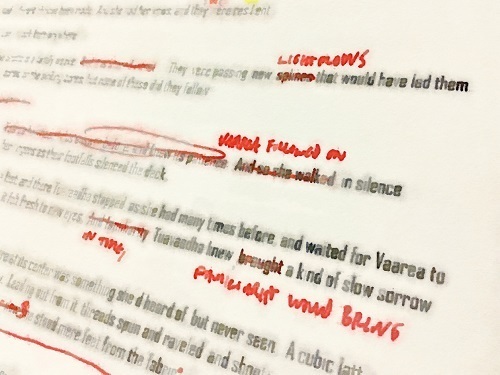
[Image 6 - ‘Edits’. CC BY-SA Heath Rezabek 2014. ]
Thea Ramer, digging through old boxes, finds a fraying printout from long before. Old habits: Reading through it, although the time for revision is long gone, she watches herself scratch through a few words, and watches her outbreath as she does so.
If there had been a reason, these crew in theory could have navigated the actual physical spaceframe of Saudade IV.
She writes above:
DNA (zygosphere)
She writes below:
Reality = Bilateral (transpose?)
Thea Reamer closes her eyes, old threads of a story unwinding; and in a blink, she’s far away.
Time shifts and adapts, enfolding again all around her.






Woven Light: Lesson Arcs
Heath Rezabek continues his experiment in possible futures, science fiction with a collaborative bent exploring the archives that may one day preserve the story of our world and the sometimes mysterious processes that may bring them into being.
by Heath Rezabek

This is the fifth installment in a continuing series of speculative fiction here on Centauri Dreams. Feedback from prior installments helps shape the themes and direction of subsequent entries, but the purpose and focus of these pieces is to explore a timeline (or timelines) in which comprehensive, resilient archives of Earth’s biological, scientific, and cultural record — deep archives for deep time — are developed through unexpected means.
Woven Light (I) – Vessel Haven http://www.centauri-dreams.org/?p=29669
Woven Light (II) – Adamantine http://www.centauri-dreams.org/?p=29897
Woven Light (III) – Augmented Dreamstate http://www.centauri-dreams.org/?p=30128
Woven Light (IV) – Proteaa http://www.centauri-dreams.org/?p=30352
Woven Light (V) – Lesson Arcs
- – - – -
In my last installment, we launched the Centauri Dreams Vessel Survey, beginning community curation of a core booklist embodying Centauri Dreams‘ themes and influences. I discussed my work with the Long Now Foundation, showcasing their work and discussing my pending trip to be present for the opening of The Interval. We will return to both of these topics in a future installment. This week, however, I’ll continue the speculative fiction arc of Woven Light here on Centauri Dreams.
2013 was a tremendous year of change and evolution for the Vessel project; in the span of that year, the Vessel proposal moved from being a conference presentation to a published proceedings paper. After joining Icarus Interstellar to help organize the first Starship Congress, the Vessel project was summarized and presented at the event. A monograph version of that session should ultimately find its way to the JBIS special issue on SC2013.
At that conference, I met Paul Gilster, and introduced him to Nick Nielsen: There began a collaboration which continues today. Perhaps the biggest advancement of all, for me, was the opportunity to serve as an Intern with the Long Now Foundation as they began the community curation process for their Manual for Civilization collection. Although this Internship is drawing to a close, the effort has planted seeds that will continue to sprout for years to come.
With clarity can sometimes come a contradictory confusion. Even as progress on the Vessel proposal assured me that this effort had much in store, I soon discovered a large complication: To make progress on the practical proposal — the Vessel Open Framework, a specification document which could help pave the way for a unified approach to very long term archives — I realized I would need time and a team. Neither of these things are easily secured. My time remains split between these efforts and my livelihood.
Sometimes, however, help comes in unexpected forms. In this case, my conflicted feelings on how to proceed with the Vessel proposal led to a rediscovery of fiction as a vehicle for evoking and envisioning possibilities that remain unreachable in reality. My work on the Woven Light story arc continues, and if anything, is picking up steam.
Likewise, with this realization has come another shift in my perspective. While I continue to feel that a practical proposal for scalable, widespread archival efforts of all kinds is necessary, I have also come to realize that equally important is the collective role of storytellers as living archives of potent possibilities. One path forwards with Woven Light is to create a kind of fiction which can be approached from many directions, including by those inspired enough by it to try their hand at its themes and scenarios themselves.
Should humanity fail in its task in the short term, and Vessel Archives (or their like) not be constructed or created in time to forestall scattered cultural collapse or stagnation, it becomes crucially important that the stories with which humanity is left retain a trace of incentive towards rebuilding. Some would say that our advancements will soon outpace our challenges. Others would say that cases of permanent stagnation and flawed realization are already underway, in nations around the world which struggle against tides of poverty or political despair.
Where, then, is the wellspring of inspiration needed to renew a belief in the possible? Even as I continue to work at the Vessel proposal as a practical deliverable, I am working more and more on a way of storytelling which above all else plants seeds of potential in the gaps between what we can foresee and what we collectively doubt is possible.
It was a surprise, in writing, to find Thea Ramer revising the first sections of Woven Light in response to the entreaty that her robots and starships were never going to make it far in the fictional world of her present-day (an alternate-timeline 1990s), which was in turn a response to the overarching suspicion of previous comments. The resurgent myth which emerged at that point is going somewhere — Vaachez descends into the bazaar in search of a guide and map to even deeper passages, and not all in the storyline is as it seems.
As we move forwards, the number of timelines at work may begin to collapse and merge a bit — and other, unexpected ones may open up. With silence in the comments, I forge ahead sounding out the way based on the echoes already at work in the world of the story. Always, of course, comment is welcomed — it’s no longer expected: All of us, perhaps, are in unexplored territory.
One thing I do foresee is that the Vessel Open Framework will begin to unfold again, from within the world of the fiction. I take as an inspiration the experience I had in 1991 when, well after the original TV series of Star Trek: The Next Generation had ended, I encountered the ST:TNG Technical Manual, by Sternbach and Okuda. Though this kind of metafictional resource had been published before, something about the depth of thought and description in this work inspired me towards a new kind of fiction, one in which the only limits are those of our own vision, deduction, and imagination. [1]
I am thankful in the extreme to Paul Gilster, for his constant encouragement and support of this effort, a form of serialized fiction perhaps not seen before on Centauri Dreams, but now belonging thoroughly to it. I am grateful for his patience as I work my way towards a myth of possible futures that somehow includes as many possibilities as we can foresee, and asks us as readers to choose between them. Which will we accept or reject? Which will we create through our vision, or our blind spots?
Even for me, there is only one way to know, and that is to follow the work where it goes.
[1] Okuda, M and Sternbach, R. Star Trek: The Next Generation Technical Manual (Pocket Books, 1991).
- – - – -

[Image 1 - ‘Manuscript: The Tracer Guild Book 1 by Thea Ramer.’ Adaptation of photography CC BY-SA Cory Doctorow ]
1994. Thea Ramer continues her work on a novel that will be called The Tracer Guild. It will be her only published work, and will reflect but a sliver of the world she is to sketch out between now and its publication in December, 1996. These two years will be spent, for her, in a frenzy of creation, drawing upon notes she has been reworking for several years already.
The Tracer Guild — planned as the first of a series — goes so confidently astray as to float the working titles of six more planned volumes. It enjoys a brief period of uptake, before becoming overwhelmed by the market. After its publication, exhausted and bemused, Thea will put aside the work, only to return many years later, by another route entirely. And she will go through many changes.
For one, she will determine to pick up her scientific pursuits again, and return to academia. This will ultimately result in her team’s development of hologlyphic syntax, and from its hologlyphic origins, the synthetic mind called Avatamsaka.
For another, she will bear a son. His name will be Aben.
- – - – -

[Image 2 - ‘CU Boulder: Resilience, Remembrance, and the Future of Humanity Symposium 2024.’ Adaptation of photography CC BY-SA devnulled 2010 ]
2023. Aben Ramer returns to Denver from the Playa, prepared to dedicate his energy to a community knowledge and resiliency center, and grassroots version of specification document known as the Vessel Open Framework. The next year, a chance meeting at a conference at CU-Boulder introduces him to Professor of Computational Psychology, Dr, Jota Kaasura.
Resilience, Remembrance, and the Future of Humanity. Symposium 2024.
Lunch Keynote: From Active Imagination to Synthetic Minds: Preserving Ancestral Symbology through Jungian Design Discovery in a Computational Matrix.
After the talk, by the side of the stage as the audience mills towards afternoon, Aben reaches the presenter. Records show him young and eager, an anxious spark in his eyes. Recovered from video, this transcript remains:
Ramer: Doctor — Dr. Kaasura, I wanted to thank you. I’d never thought about it quite that way — the synthesis […unclear…] meaning through visualization — thanks for painting the picture. Oh — I’m Aben.
Kaasura: Yes, thank you. Call me Jota. I appreciated your question, ah.., Aben.
Ramer: Thanks. Ok, well so, you also mentioned that your team was seeking volunteers for the Thematic Sampling phase of input. I’ve practiced Active Imagination before, just a little, and I’d love to participate. I’m in Denver, so getting to CU’s not a problem.
Kaasura: Ah! You have? Well, excellent! It’ll be a bit yet as we gather applications. Here’s the lab’s card. We can certainly explore the possibilities. We’ll take your application and history, and we’ll go from there.
Ramer: Great. Great!
Kaasura: Out of curiosity, how did you run across Active Imagination?
Ramer: My mother used to use it for creative inspiration. She was a writer, years back — she’s actually in AI research as well, now — holography, holographic syntax. Dr. Thea Ramer?
Kaasura (brightening): Ah! Yes, yes, I know her work. Small world! She’s — didn’t she break some new ground, so to speak, in New York last year?
Ramer: Well, yes, that’s — yeah, I guess it was a breakthrough, really. But after what happened, she’s actually on sabbatical now. She says she’s not sure if she’ll return to it. I’m not quite clear on why. But she’s writing it up, so there’s time. She’s here, in fact! Well, not here-here. She was’t up for the conference, too soon she says. But she’s staying with me in Denver. We’re going through her old fiction, her drafts, trying to catalog.
Kaasura: (…) Interesting. Yes, you know, I’d actually love the chance to speak with her, if the chance comes up. Holographic syntax holds great promise. It’d be a shame for her to let it go. I mean, work goes on, always, of course, but sometimes there’s a spark, and it’s always worth perking up when that’s so. Something worth doing, there.
Ramer: Yeah. I’ll tell her. She’ll appreciate it. Maybe we can set something up. I mean she’s right here, really… Too near for a miss, right?
Kaasura: Right. Right. Good way to put it! Well, there’s my card — I do have to go, but we’ll look forward to –
Ramer: Absolutely. Thank you. I really appreciate what you’re doing, and especially why you’re doing it. Thanks for sharing that.
Kaasura: Well, thanks for such an interesting question. The unexpected ones are the best, aren’t they?
Ramer: I’ll bet they are. Great. See you soon!
Kaasura: Yes. See you soon.
- – - – -

[Image 3 - ‘Proteaa: Dyson Eggs, Living Archives’ (Detail) Heath Rezabek. Adaptation of photography CC BY-SA Wikimedia. ]
Timeframe Unknown. A reflective, refractive sphere, brimming with a maelstrom of living matter, drifts through endless night, tracing the edge of gravity’s embrace. Though utterly alone, it is not lonely, as the Protean cells which form its very quanta are entangled with many other such vessels, peer civilizations spiraling in affinity. True entanglement is a strange thing. Most of these entangled peers are smaller than itself. Most do not share the same origin. Most do not share the same gravity (which means locality, or galaxy), or space, or time.
Some, though not all, have sails; and all such sails stream ancient light.
At least one of these bears passengers, deep in stasis, living — ponderously, glacially, but metabolically living — archives.
At least one of these living archives bears the name of Ramer.
And each Ramer contains the rest.
How did this come to be?
- – - – -

[Image 4 - ‘Pendulum: Lesson Arc’. Adaptation of photography CC BY John Morgan 2013. ]
It was possible to become lost in here.
This much was well known, and all were taught the telltale signs of probability sickness early on. Vaarea Ramer did well in her lesson arcs, the small worlds adrift in fog on which she had learned to discern Realia from its echoes and shadows and subcreations.
She tracked the arc of the pendulum, swinging, swinging above an ancient pool, reflecting a blinding blue sky with each pass. Ancient, it seemed. Swinging, she felt. It was easy, seeing such a simple scene, to believe it grounded and absolute.
But she stood upon a sort of observation deck, and between her and the pool lay a gap too wide to leap, filled with fog. And beside her stood her family’s Mentor, Tuavaadha, nodding behind her veil.
~Yes, Vaarea. The pendulum would stop in time, if we waited here long enough. But there is much more to do, and even I might become bored waiting so long as that.~
Vaarea lifted her eyes, scanning the clouds for signs of anything but stasis. Her thoughts felt like a sound she heard, unspeaking, though she was the one projecting. She was used to this by now. ~What else is there to do?~
~After the Pendulum Pool comes the Grotto; at least for you. And all of your line, stretching back and back, have found it more interesting a place to be.~ Tuavaadha smiled, she knew without seeing.
And of course, she knew that she was being nudged, poked and tested, gently but inevitably. Vaarea felt a familiar irritation, which resolved itself in its familiar way into a motion of the hand. Lifting from her sash a small shard of smooth stone, she rubbed it twice with her thumb, and felt its weight shift to signal that a beacon had been placed. She’d be back, she was sure.
~As sure as your father. As sure as your son.~ Tuavaadha strode forwards, holding out her palm. A Mentor’s palm seems as wide as night, when it’s open, thought Vaarea.
She placed the stone there, and waited for the blink. But this time was different. To her right, out of eyeshot, she felt something shift and slide, and turned to see a panel of the observation platform falling away. Underneath, familiar lines of woven light interlaced and parted, indexing the scene and retracing the Voronoi frame around them.
~What about the Grotto?~ she quested, following Tuavaadha below.
~We’ll get there, impatience. We just can’t from here.~
Vaa stopped, furrowed. ~Since when can’t we get to one pattern from another?~
~Since the time it was woven that way, which means everfore.~
They were moving now, wisdom bodies flowing past the index lattice, passing pods where her peers slept and drifted, suspended in the weave.
~How far, then?~
~Not far.~
~A different lattice?~
~A different loom.~
A different loom! Now surely there was no reason they couldn’t trace a thread from one pattern to any other while remaining in the same loom. Unless by design, but why?
~Security, for one part,~ rang Tuavaadha. ~But only one part. There is something to the journey, sometimes. Something worth doing. You should know this better than most, being spun as you have from the thread of all Ramers.~
The Ghemaai were not prone to resentment, but an ancestor of Vaarea’s might have felt something sharper at the reminder that great choices had been made for her, long before her, which as far as she knew she could not unchoose. But she knew that she was also here, and alive, and flowing starwards with them all, in a way she could not be had different choices been made. And she had her vows, and they were resilient.
~So what is this, then? This Grotto we can’t reach from anywhere?~
~Anywhere else~ adjusted Tuavaadha. ~The Grotto is a family weave. ~ They were passing, now, lightflows that would have led them off towards the flowing cores, or the gathering cores, or the sinking cores; but none of these did they follow.
Tuavaadha said nothing, but smiled beneath the quiet; and Vaarea followed. So they went, in silence, weighing the memory of her shardstone, lacing it between her fingers as their footfalls silenced the deck.
Up ahead, in time, they reached a branching, and another, and a last; and there Tuavaadha stopped, as she had many times before, and waited for Vaarea to read the weave before them. It was old, but always the first time it felt fresh to new eyes. In time, Tuavaadha knew, familiarity would bring a kind of slow sorrow more like joy, keen enough to earn a name. But this time was new time.
Vaarea blinked, reaching out to touch the woven pattern of this tale. There at its center was something she’d heard of, but never seen. A cubic lattice the size of her fist was held tilted and sunken in the center of a circular plateau. Leading out from it, threads spun and raveled, and shoots reached up from loamy soil, sheltering the small camp arrayed there. This close to the fabric, she could see that the lattice stood in for a fire.
Vaarea had learned of shelterfires not two lessons prior, and shivered at the glacial cold she thought they’d left behind in a liminal valley beset by frozen seas. Around this fire sat and stood a dozen, maybe fewer, maybe more; a handful huddled – but against what cold she couldn’t see.
These grassy trees seemed city walls for them, golden green and thriving. And their tips brushed at a dusted, starry sky.
She knew better than to trace too long the lines between these diamonds, but she couldn’t help seeing the similarity – a kinship she’d never noticed in these tapestries before – between the lattice at the heart of this little shelterfire, and the splaying array of stardust beyond these trampers’ reach.
These trampers, she guessed, had tramped the path to this pattern here and now. Why so huddled? Why so intent upon the fire, if not for warmth? It shimmered and billowed, a tiny curtain, golden and ghostly above embers.
She wished she could see one in Realia. She wished she could see one patterned here and now.
~But you can, Vaarea Ramer. And you always will be able.~
So reaching out, she brushed it gently with one fingertip. And sometimes, in such places, the slightest touch is enough.
- – -

[Image 5 - ‘Woven Fire’. Adaptation of photography CC BY-SA Mathias Erhart 2009. ]
Aben Ramer sat before the fire, stirring its coals. “I am old, now… But once I was young, like you, and you as well,” he began.
Young eyes looked up, in awe at their elder. They had heard this beginning before, many times; always – every time – it ran on from there differently than the time before. And always – every time – it ran on like a new stream down the same mountain.
As old Aben Ramer spoke, the children gazed and rested, their eyes sifting firelight, and then lost themselves in patterns ever changing, never changed, woven of golden light; and in through its murmuring cracks could be glimpsed the most ancient of archives, finding itself revealed again, deciphered again, read out and comprehended, voiceless and booming.
Up reached Old Ramer’s arms,
and as tall as the shoots far above them he seemed;
and as full seemed the sky as their hearts and their eyes;
and the stars seemed as close as the sparks which there met them;
and as sure seemed the song of Old Ramer as morning.
And in the morning, the children awoke from dreams of a dragonfly in the night, flowing starwards, wings like sails unfurling, ringed about with an arcing bowl of starlight. And among them was a girl, whose name was a new one; they just called her V.
- – -
Vaarea, stunned, hours or years later, stood just as she had before the weave, finger fading from the cubic lattice turned to fire before her. Tuavaadha smiled. ~This place – can I come here?~
~Of course; any time. All you need to do is seek it, awake or asleep, and remember that you’re seeking.~ Tuavaadha paused. ~But it helps to have some methods. In the Grotto, you will learn them.~
~That wasn’t the Grotto?~
~It was, reflected. But emulators are for studies; this place is for dreaming. We can go there tomorrow. Tonight, your assignment is just to ponder one thing, while you rest and you wait.~
Vaarea looked up, still not fully present.
~?~
~The fire: Where did it come from? Where is it going? What does it preserve? What does it destroy? Is memory stored there? And if not there, then where?~
Vaarea looked at the lattice, shimmering softly, woven into this meshwork, and closed her eyes to recall true flame, true flame unseen but everthere. She furrowed; she sighed; she looked to her Mentor for more.
~These seem like different questions, but they are not. They are conjoined. Why? For matter–
–is slumbering light~ Vaarea concluded.
Tuavaadha nodded contentedly, as any Mentor would. ~Now rest.~
- – - – -

[Image 6 - ‘Edits’. CC BY-SA Heath Rezabek 2014. ]
Thea Ramer, digging through old boxes, finds a fraying printout from long before. Old habits: Reading through it, although the time for revision is long gone, she watches herself scratch through a few words, and watches her outbreath as she does so.
If there had been a reason, these crew in theory could have navigated the actual physical spaceframe of Saudade IV.
She writes above:
DNA (zygosphere)
She writes below:
Reality = Bilateral (transpose?)
Thea Reamer closes her eyes, old threads of a story unwinding; and in a blink, she’s far away.
Time shifts and adapts, enfolding again all around her.






June 19, 2014
Outer Planet Exploration Strategies
I’ll wrap up this week’s outer planet coverage with a look at recent Cassini flybys of Titan, but I also want to put these accomplishments in the context of what we might do with future missions to the ice giants Uranus and Neptune like the proposed ODINUS missions we looked at yesterday. One-off missions to explore a planet and its satellites collect highly detailed data, but comparative studies of the giant planets require accumulating datasets separated by decades. Are there alternatives?
Let’s hold that thought as we look at Cassini in this light. The flyby designated T-101 occurred on May 17 and was highlighted by Cassini beaming radio signals over Ligeia Mare and Kraken Mare, the two largest seas on Titan. The idea here is to bounce the signals off the surface of the lakes so that they are received by the ground stations of the Deep Space Network here on Earth.
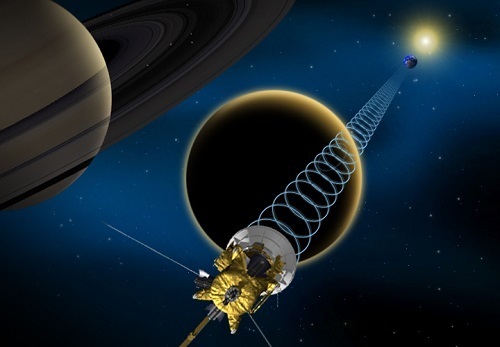
Image: Signals bounced off Titan can reveal important details about the moon’s surface. Credit: NASA/JPL-Caltech.
Called a bistatic scattering experiment, the radio signals encode information about Titan’s surface, including its solidity, reflectivity and composition. The attempt using the two seas in May demonstrated that specular reflections of the radio frequencies could be detected by the DSN. Essam Marouf (San Jose State), a member of the Cassini radio science team, describes the result: “We held our breath as Cassini turned to beam its radio signals at the lakes. We knew we were getting good quality data when we saw clear echoes from Titan’s surface. It was thrilling.”
The June 18 flyby, T-102, performed the same bistatic scattering experiment, during an approach that took the spacecraft just 3659 kilometers above the surface of the moon. Both flybys also experimented with radio occultation, as this NASA news release explains. Here a signal from Earth is sent through Titan’s atmosphere toward the Cassini spacecraft, which responds with an identical signal. Temperature and density differences can be teased out of the transaction, a method that has been used for several earlier occultations of Saturn.
The May flyby demonstrated that signal lock could be achieved quickly, making the method a useful tool in our efforts to track atmospheric variations during Titan’s changing seasons.
“This was like trying to hit a hole-in-one in golf, except that the hole is close to a billion miles away, and moving,” said Earl Maize, Cassini project manager at NASA’s Jet Propulsion Laboratory in Pasadena, California. “This was our first attempt to precisely predict and compensate for the effect of Titan’s atmosphere on the uplinked radio signal from Earth, and it worked to perfection.”
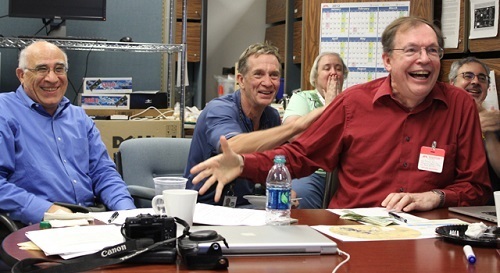
Image: Cassini team members react with excitement to the successful receipt of radio signals bounced off of Titan during a flyby on May 17, 2014. Credit: NASA/JPL-Caltech
If only we had a spacecraft as capable as Cassini orbiting Uranus and Neptune, as at least one commentator here noted after yesterday’s post on ODINUS, twin spacecraft that would orbit the two worlds in a new proposal for the European Space Agency. We could then imagine repeated flybys of Triton, that mysterious geologically active moon that circles Neptune in a retrograde orbit, while performing a variety of studies on the satellite system at Uranus. I want to drop back into the ODINUS paper to cite its statements on this matter, which remind us how little data we have on these moons since our only close encounter has been through the Voyager flybys:
The satellites of Uranus and Neptune are poorly known, mostly due to the limited coverage and resolution of the Voyager 2 observations. The Uranian satellites Ariel and Miranda showed a complex surface geology, dominated by extensional tectonic structures plausibly linked to their thermal and internal evolution… Umbriel appeared featureless and dark, but the analysis of the images suggests an ancient tectonic system… Little is known about Titania and Oberon, as the resolution of the images taken by Voyager 2 was not enough to distinguish tectonic features, but their surfaces both appeared to be affected by the presence of dark material.
As for Triton, it is itself a prime inducement to put such a mission together:
The partial coverage of the surface of Triton revealed one of the youngest surfaces of the Solar System, suggesting the satellite is possibly more active than Europa… Notwithstanding this, the surface of Triton showed a variety of cryovolcanic, tectonic and atmospheric features and processes… The improved mapping of these satellites, both in terms of coverage and resolution, would allow to study their crater records and their surface morphologies, which in turn would provide a deeper insight on their past collisional and geophysical histories.
Both Galileo and Cassini have given us in-depth looks at a gas giant and its satellites, and we now ponder the kind of follow-ups that will investigate specific areas like the interior of Jupiter (Juno) and specific Jovian moons like Ganymede, Callisto and Europa (the JUICE mission). Cassini’s successes have been spectacular, but I like the approach that Diego Turrini and his colleagues take when they observe that comparative studies of the gas giants involving separate missions demand the completion of each before a full assessment of their data can begin.
Instead, Turrini argues for ODINUS as “…two M-class spacecraft to be launched toward two different targets in the framework of the same mission.” The tradeoff is likewise obvious: While we get comparative planetary data — in this case on the ice giants Uranus and Neptune — in a shorter timeframe, we also need to produce two spacecraft and manage them simultaneously, likely limiting the amount of instruments in the scientific payload of each. Can we find a way to do this while still achieving the high-quality science we expect from separate dedicated missions?
It’s an open question, and every Cassini success speaks to the value of the more traditional approach, but we should be looking at ways to speed up the comparative data return in future missions. It will be interesting to see how ODINUS fares among its ESA critics. The Turrini paper cited here and yesterday is “The Scientific Case for a Mission to the Ice Giant Planets with Twin Spacecraft to Unveil the History of our Solar System,” submitted to Planetary and Space Science (preprint).






June 18, 2014
Return to the Ice Giants
Once New Horizons has performed its flyby of Pluto/Charon and, let’s hope, its reconnaissance of a Kuiper Belt object (KBO), what comes next in our exploration of the outer Solar System? Pushing further out, Innovative Interstellar Explorer grew out of a NASA ‘Vision Mission’ study and has been developed at Johns Hopkins University Applied Physics Laboratory by Ralph McNutt and team. Boosted by a Jupiter gravity assist, IIE would explore the interstellar medium some 200 AU and further from the Sun, using a plutonium-fueled 1 kW electric radioisotope power supply.
And then there’s Claudio Maccone’s FOCAL mission, which would target the Sun’s gravitational focus beginning at 550 AU, continuing well past 1000 AU for observations exploiting gravitational lensing effects. FOCAL has been the subject of intense study — Maccone’s 2009 book Deep Space Flight and Communications grew out of this decades-long work — and with both IIE and FOCAL we have the prospect of making observations of the medium through which any future interstellar mission would pass, having exited the heliosphere inflated by the solar wind from the Sun.
But there is much to do in the region between the gas giants, with their astrobiologically interesting targets Europa and Enceladus and the seductive Titan, and the inner edge of the Kuiper Belt. Here we are in the domain of the ice giants last visited by the Voyagers in the 1980s. A new paper from Diego Turrini (Institute for Space Astrophysics and Planetology INAF-IAPS, Italy) and colleagues makes the scientific case for a mission to Neptune and Uranus, to be flown by two identical spacecraft. The ESA-funded mission would have a launch date of 2034.
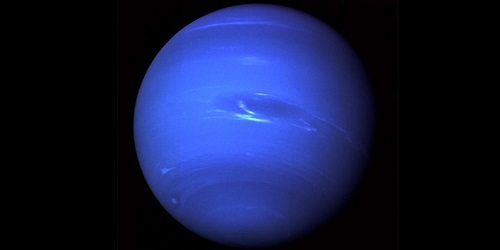
Image: Neptune as captured by Voyager 2 in 1989. Credit: NASA/JPL.
I want to focus on Turrini and team’s discussion of planet formation this morning, because this is where the scientific payoff for a return to Uranus and Neptune is the most profound. The rising tide of exoplanet research is uncovering more and more planetary systems showing us that the old view of planet formation as an orderly process producing stable, well-spaced systems is incorrect. Systems around other stars are not necessarily patterned on what we see in the Solar System. In fact, it is we who seem to be the outliers, confronting a cosmos that produces a bewildering array of planetary configurations in which migration surely plays a major role.
Thus the ‘Jumping Jupiters’ mechanism that involves close gravitational encounters that occur after the original circumstellar disk has dispersed. In our Solar System, our changing views have led to the ‘Nice Model,’ which involves our own jumping Jupiter scenario, one tied to the era known as the Late Heavy Bombardment. Here we have a series of encounters between the giant planets, with interactions with what the paper calls a ‘massive primordial trans-Neptunian region.’ The end result is to take giant planets once closer to each other and to move Jupiter inward while migrating Saturn, Uranus and Neptune outward. The paper describes this scenario:
The importance of the Nice Model lies in the fact that it strongly supports the idea that the giant planets did not form where we see them today or, in other words, that what we observe today is not necessarily a reflection of the Solar System as it was immediately after the end of its formation process. Particularly interesting in the context of the study of Uranus and Neptune is that, in about half the cases considered in the Nice Model scenario, the ice giants swapped their orbits (Tsiganis et al. 2005). The success of the Nice Model in explaining several features of the Solar System opened the road to more extreme scenarios, also based on the Jumping Jupiters mechanism, either postulating the existence of a now lost fifth giant planet (Nesvorny et al. 2011) or postulating an earlier phase of migration and chaotic evolution more violent and extreme than the one described in the Nice Model (Walsh et al. 2011).
Mixing of the solid materials that make up the primordial Solar System would have occurred, with both inward and outward fluxes of ejected material affecting the composition of primordial planetesimals. When we look at the satellites of the gas giants today, we may be seeing material that was originally extracted by these processes from the inner Solar System and incorporated in their systems.
Uranus and Neptune would have been strongly affected by these events, with a giant impact involving Uranus that explains its sideways rotation. And we can see other evidence in the capture of Triton by Neptune, Triton being a moon that orbits in the opposite direction to its host planet. The paper continues:
…our view of the processes of planetary formation and of the evolution of the Solar System has greatly changed across the last twenty years but most of the new ideas are in the process of growing to full maturity or need new observational data to test them against. The comparative study of Uranus and Neptune and their satellite systems will allow to address the problems still open, as the ice giants were the most affected from the violent processes that sculpted the early Solar System and yet they are the least explored and more mysterious of the giant planets.
Turrini and team also make the case that based on data from the Kepler mission, about one star in every five should have a Neptune-class planet, but the only up-close data we have on this class of planet comes from the Voyager 2 flybys of Uranus and Neptune performed in the 1980s. Here the authors have to pause, for Kepler’s candidates have short orbital periods because of the nature of Kepler’s operations. Kepler can only detect ‘warm’ or ‘hot Neptunes,’ whose composition and dynamics will differ from the ice giants in our own Solar System. Even so, characterizing our ice giants is something we can do with existing space technologies, and it can offer up templates for interpreting the data returned from future exoplanet observations.
From observation of the satellite systems around the ice giants to study of planetary interiors, there is much to investigate in the outer Solar System. The ODINUS mission described in the paper would put a spacecraft into orbit around both Neptune and Uranus, an ambitious goal that would allow measurements with the same set of instruments in both systems, as well as studies of the interplanetary medium from different angular positions during cruise. The ESA’s Senior Survey Committee has already stated that exploration of the ice giants “appears to be a timely milestone, fully appropriate for an L class mission,” assuming financial support emerges.
There is no question we are going to get payloads back to Uranus and Neptune at some point, and the Turrini paper makes a strong case for the scientific validity of the effort in helping us understand our own system’s violent past and the results of our planet-hunting observations in other systems. The comparatively well studied Jupiter and Saturn are composed mainly of hydrogen and helium, while Neptune and Uranus are dominated by water, ammonia and methane along with metals and silicates, with hydrogen and helium making up a scant 25 percent. We obviously have much to learn about such planetary formation outcomes.
The paper is Turrini et al., “The Scientific Case for a Mission to the Ice Giant Planets with Twin Spacecraft to Unveil the History of our Solar System,” submitted to Planetary and Space Science (preprint).






June 17, 2014
New Horizons: Hubble Hunts KBOs
My guess is that the public thinks of the Hubble Space Telescope largely in relation to deep space objects. The Hubble Ultra Deep Field is a case in point, a region of the sky in the constellation Fornax that is no more than a tenth of the width of a full moon, but one that contains 10,000 galaxies. An image of the HUDF augmented by near-ultraviolet data has had considerable play in the media, showing star birth in galaxies five to ten billion years ago. It’s too lovely not to show here.
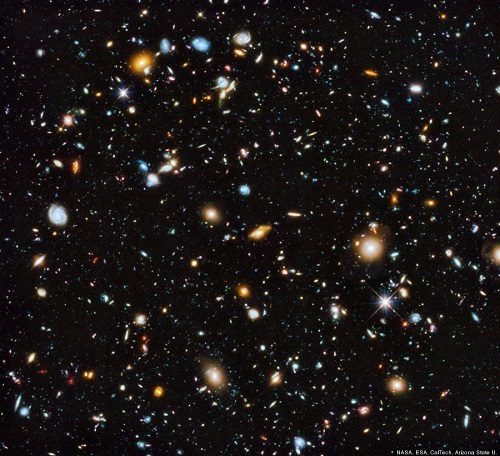
Image: The Hubble Ultra Deep Field with near-ultraviolet data, a false-color image that is the result of data acquisition from 841 orbits between 2003 and 2012. Credit: NASA/ESA/Caltech/Arizona State.
The HUDF attests to Hubble’s range, but we also know from Hubble’s studies of objects in our own Solar System that it can support ongoing planetary missions. Astronomers will now use the space observatory to help find tiny objects against the background of an immense starfield in Sagittarius. After consideration of the mission and the value of the data it will return, the Hubble Space Telescope Time Allocation Committee has recommended that the instrument be used to search for a Kuiper Belt Object that New Horizons can visit after its flyby of Pluto/Charon in 2015, a search contingent upon results of a pilot observation program using Hubble data.
We have two Voyagers still sending data as they push into interstellar space, but only New Horizons has a fully functioning set of instruments and the capability of making the necessary course alterations to perform a KBO flyby. The problem has been to identify the target, a hunt that could begin no earlier than 2011 because KBO candidates needed to be converging on the region of space that New Horizons can reach after the Pluto/Charon encounter. The 8.2-meter Subaru Telescope in Hawaii and the 6.5-meter Magellan Telescopes in Chile have so far been deployed on the task but it looks like it will take Hubble to make the call.
For of the roughly fifty new KBOs that the Subaru and Magellan instruments have thus far identified, none is within range of the spacecraft’s ability to maneuver. This is an extremely difficult search field, one that looks into the plane of the galaxy toward Sagittarius, and astronomers are searching for something that is both small and likely to be as dark as charcoal. But finding a target is important — the Kuiper Belt consists of debris from the Solar System’s formation, and we’ve never had the opportunity to get a close-up look at one of these objects.
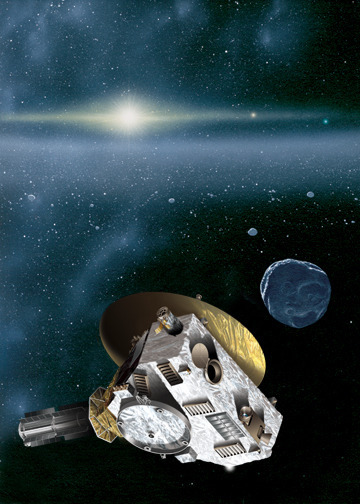
If Subaru and Magellan haven’t been able to find the right KBO, Hubble will try something different, turning at the rate that KBOs are predicted to move against the background stars. As this Space Telescope Science Institute news release explains, the result will be that KBOs will show up as pinpoint objects amidst a swarm of streaky background stars. Assuming the initial test observations — 40 orbits of Hubble observing time — show that the telescope can find at least two KBOs of the specified brightness, additional observing time covering a period of 156 orbits will be allotted to search a field of view the angular size of the full Moon.
Let’s wish Hubble success because New Horizons is the successor to the Voyagers, like them involved in a journey that should captivate and inspire our culture. The more science we can get out of it, the better, even though putting a payload past Pluto/Charon is itself a grand accomplishment. As for Hubble, its efforts on behalf of New Horizons point to its previous discovery of four small moons in the Pluto/Charon system as well as its search for dust rings that might have compromised the mission. Just as Hubble has proven its worth again and again in terms of planetary science (and don’t forget its contributions to the Dawn mission), we can hope for equally impressive accomplishments from the coming James Webb Space Telescope.






June 16, 2014
What to Look for at Charon
Let me suggest that you mark August 25th on your calendar. It’s the day we celebrate the 25th anniversary of Voyager 2’s closest approach to Neptune in 1989. That would be reason enough to look back and remember — marveling all the while at the Voyagers’ continuing mission — but it’s also the day when New Horizons will cross the orbit of Neptune. At work, as principal investigator Alan Stern points out in his latest PI’s Perspective, is ‘cosmic coincidence not design,’ but what a moment it will be as New Horizons moves at last into ‘Pluto space.’
90 percent of the long journey is over, with a bit more than 300 million miles to go before the encounter with Pluto/Charon next summer. Newly awakened from hibernation, the spacecraft will be put through a complete checkout of its onboard systems and scientific instruments, as well as conducting its first optical navigation campaign to study the approach into Pluto. Stern also reports that the upcoming cruise science will include imaging Pluto and its moons to study their light curves, seen by the spacecraft at a different angle than can be observed from Earth.
One more period of hibernation will occur before New Horizons is awakened in December, at which point the beginning of the encounter phase will be closing in. Recent work out of NASA GSFC, and an accompanying paper in Icarus, thus comes against the backdrop of a mission that will soon be answering many of our questions about this distant system. Alyssa Rhoden and team have developed a model that points to how we can study the possibility that Charon once had an underground ocean. Says Rhoden:
“Our model predicts different fracture patterns on the surface of Charon depending on the thickness of its surface ice, the structure of the moon’s interior and how easily it deforms, and how its orbit evolved. By comparing the actual New Horizons observations of Charon to the various predictions, we can see what fits best and discover if Charon could have had a subsurface ocean in its past, driven by high eccentricity.”
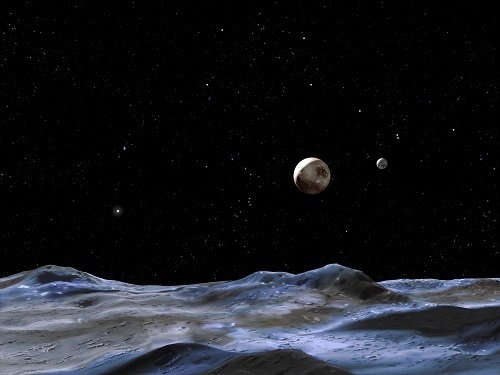
Image: This artist concept shows Pluto and some of its moons, as viewed from the surface of one of the moons. Pluto is the large disk at center. Charon is the smaller disk to the right. Credit: NASA, ESA and G. Bacon (STScI).
Both Europa and Enceladus show evidence for interior oceans, each experiencing tides that cause the interior to flex and heat enough to keep water under the ice in liquid form. What happened in the Pluto/Charon system depends upon its history. Charon could have had a highly eccentric orbit in the past that generated large enough tides to produce surface fractures. As tidally induced friction occurred in the interior of both Pluto and Charon, Pluto’s rotation would have slowed while Charon’s speeded up as the moon moved further away. Rhoden continues:
“Depending on exactly how Charon’s orbit evolved, particularly if it went through a high-eccentricity phase, there may have been enough heat from tidal deformation to maintain liquid water beneath the surface of Charon for some time. Using plausible interior structure models that include an ocean, we found it wouldn’t have taken much eccentricity (less than 0.01) to generate surface fractures like we are seeing on Europa. Since it’s so easy to get fractures, if we get to Charon and there are none, it puts a very strong constraint on how high the eccentricity could have been and how warm the interior ever could have been.”
So we have one more thing to look for as we approach Pluto/Charon next year. Bear in mind that Charon is unusually massive when compared to the body it orbits, about one-eighth of Pluto’s mass. Scientists believe the moon formed much closer to Pluto as the result of an impact that ejected material from Pluto to form the system of moons. Charon’s orbit is now circular, with a rotation rate that keeps Pluto and Charon showing the same side to each other at all times. Without significant tides in its present orbit, the odds are that any underground ocean inside Charon is long frozen.
The paper is Rhoden et al., “The interior and orbital evolution of Charon as preserved in its geologic record,” Icarus, published online 30 April 2014 (abstract). This NASA news release has more.






Paul Gilster's Blog
- Paul Gilster's profile
- 7 followers



